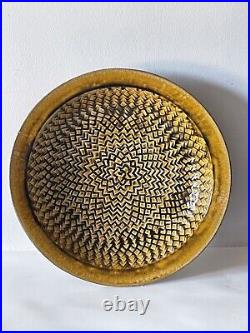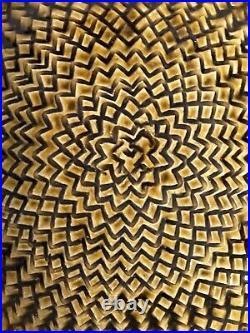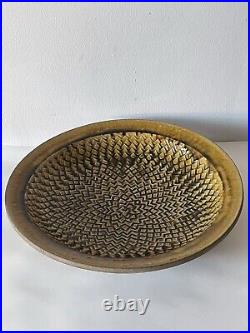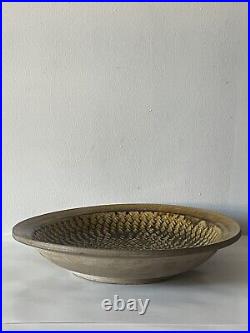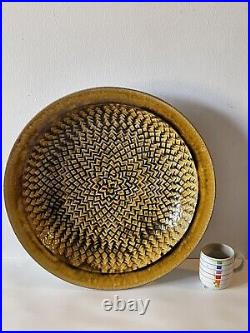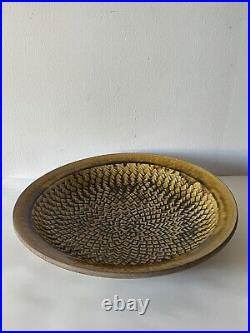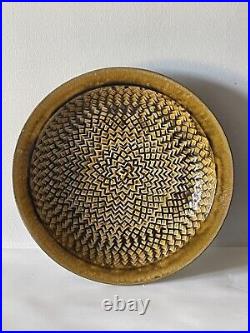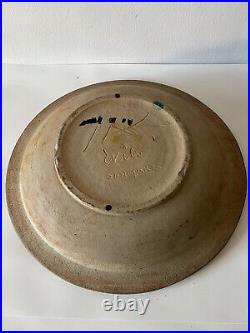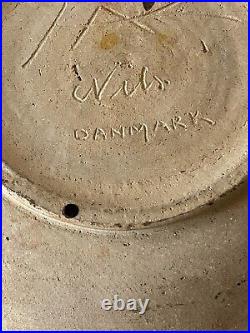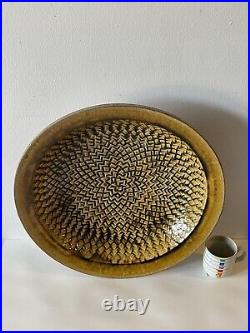DIMENSIONS: 18″W x 18″L x 4H. Kähler and known for taking the lead in exporting for the ceramic firm Kähler, following the second World War. New designs and new distribuion expanded Kähler’s influence and popularity worldwide. In 1839 Herman J. Kähler immigrated to Næstved from Northern Germany. Shortly after his arrival, he started his own pottery in Næstved, where it all began. Kähler was a trained potter, and staying true to the old traditions, he stuck to production of articles for everyday use as milk dishes, soup pails, jam jars etc. However, he was best known for his production of all-night burners. Kähler ran the company from 1839 to 1872. During that period he fathered seven children. When Herman Joachim Kähler retired in 1872, his sons Herman August Kähler and Carl Frederik Kähler took over the company, dividing the production between them. Carl Frederik continued the pottery production, while Herman August became the one who put Kähler ceramics on the world map. After having served his apprenticeship with his father, H. Kähler took glaze painting lessons at Holmegaard Glassworks. After Holmegaard he roamed from town to town in search of employment, as did most other craftsmen of the time. He travelled around Europe, employed in workshops in Berlin, Strasbourg and Paris. In 1875 he built a new facility, today known as Kählersbakken, where he began grappling with artistic design and experimenting with glazes. The artistic commitment attracted many distinguished Danish artists, and H. Kähler founded the artistic colony in Næstved. The lustre colours became his distinguishing feature, particulary the red lustre. Normally it was used only for decoration, but at the 1889 Exhibition Universelle in Paris he exhibited a product that had been completely immersed in the metallic red lustre glaze. Together with his signature, HAK, the red lustre colour became Kähler’s brand identity. Kähler was also a man of the world and generated international interest in Kähler’s ceramics. He showed his art pieces at exhibitions around the world, which attracted much attention among dealers and museums in Paris, New York, Chicago, Malmö, Stockholm, Brussels, Berlin and San Francisco. Kähler played an enormous role for the Kähler workshop. Today, his initials, HAK, are stamped on the bottom of all Kähler products. In 1917 Hermen H. Kähler took over the compant after his father H. Times and tastes had changed, and figures such as lionshaving lunch or non-shaped, strong-coloured vases and jars were no longer in demand. Kähler went back to old pottery traditions and started to produce wheel-thrown objects decorated with old technique, horn painting. His style was Art Noveau, but with his own personal twist. Kähler’s strength was his ability to inspire and encourage skilled decorators to go beyond the current decorative techniques. This slip decorations were a characteristic feature of Kähler pieces during the Herman H. In spite of being one of the Kähler family’s greatest designers and lauching that triggered the great slip decoration trend with his artistic version, his reputation in the years that followed was less brilliant. Kähler is not considered a significant figure in the Kähler history, perhaps because it was difficult for him to live up to the legacy of his father, H. Moreover, there were a number of great and less artists employed at the workshop during that period who where less modest than Herman H. In 1940, Nils Kähler and his brother Herman Jørgen Kähler took over the workshop. This would be the last generation of the Kähler family to run the company. Both brothers worked as designers, but Nils soon took over the artistic side, while Hermen J. Was responsible for the administrative and practical functions. Nils was also known as “the young Kähler”. The brothers had been a regular presence in the workshop since they were boys, and that is where they received most of their traning. In 1931, Nils replaced the workshop’s old thrower. He then developed a passion for throwing large vases. For the fun of it, Nils began modelling piggy banks and other animals. Normallym this would be a job for an apprentice, but the idea of such animals as collectors’ items was taken seriously and put into production. These animals became some of the most popular products in the history of Kähler. The animals allowed Nils to indulge his preference for ceramics decoration with slipped horn painting and lead glaze. Nils Kähler had a special talent for following the design trends of the time, which is evident from his production. Even though he was very enthutiastic about old art of pottery, the production was characterised by simple designs. He made designer objects such as ashtrays, vases, jugs and lamp feet for Le Klint lamps. They were made out of stoneware, raw with no glazing, with his preferred salt glaze or the strong turquoise colour. The era as a family-run company with the fourth generation of the Kähler family in 1974. For more than 130 years, Kähler was the meeting place of distinguished artists. This item is in the category “Pottery & Glass\Decorative Cookware, Dinnerware & Serveware\Bowls”. The seller is “vintagerotty” and is located in this country: US. This item can be shipped to United States, Canada, United Kingdom, Denmark, Romania, Slovakia, Bulgaria, Czech Republic, Finland, Hungary, Latvia, Lithuania, Malta, Estonia, Australia, Greece, Portugal, Cyprus, Slovenia, Japan, China, Sweden, South Korea, Indonesia, Taiwan, South Africa, Belgium, France, Hong Kong, Ireland, Netherlands, Poland, Spain, Italy, Germany, Austria, Bahamas, Israel, Mexico, New Zealand, Singapore, Switzerland, Norway, Saudi Arabia, United Arab Emirates, Qatar, Kuwait, Bahrain, Republic of Croatia, Malaysia, Chile, Colombia, Costa Rica, Panama, Trinidad and Tobago, Guatemala, Honduras, Jamaica, Barbados, Bangladesh, Bermuda, Brunei Darussalam, Bolivia, Egypt, French Guiana, Guernsey, Gibraltar, Guadeloupe, Iceland, Jersey, Jordan, Cambodia, Cayman Islands, Liechtenstein, Sri Lanka, Luxembourg, Monaco, Macau, Martinique, Maldives, Nicaragua, Oman, Pakistan, Paraguay, Reunion.
- Origin: Danish
- Antique: Yes
- Shape: Round
- Occasion: All Occasions
- Color: Multicolor
- Item Diameter: 18
- Year Manufactured: 1960
- Material: Ceramic
- Set Includes: Bowl, Charger Plate
- Item Depth: 18
- Vintage: Yes
- Brand: Nils Kahler
- Type: Charger Plate
- Original/Licensed Reproduction: Original
- Era: Mid 20th Century (1941-1969)
- Item Height: 4
- Style: Mid-Century Modern
- Features: Decorative, Limited Edition
- Production Style: Art Pottery
- Time Period Manufactured: 1960-1969
- Production Technique: Pottery
- Country/Region of Manufacture: Denmark
- Handmade: Yes
- Item Width: 18
